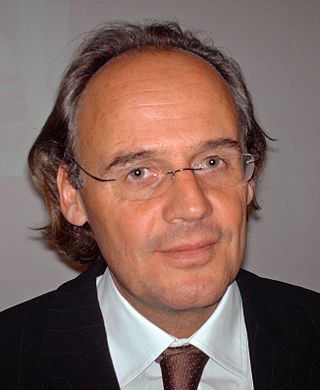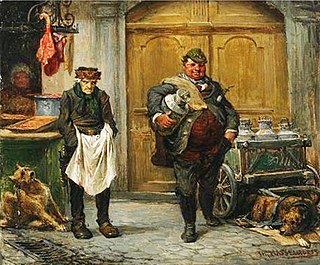
Christiaan Dirk Tonnis is a German symbolist/realist painter, draftsman, video artist and published author. He studied at the HfG Offenbach with Dieter Lincke and Herbert Heckmann, and lives in Frankfurt, Germany.

Stefan Szczesny is a German painter, draughtsman, and sculptor. He is best known for co-founding the Neue Wilde movement in the early 1980s.

The Museum für Moderne Kunst, or short MMK, in Frankfurt, was founded in 1981 and opened to the public 6 June 1991. The museum was designed by the Viennese architect Hans Hollein. Because of its triangular shape, it is popularly called "piece of cake". Since 2018, Susanne Pfeffer has been director of the MMK.
Robert Klümpen is a German painter.
Thea Djordjadze is a contemporary German-Georgian artist based in Berlin, Germany. She is best known for sculpture and installation art, but also works in a variety of other media.
Eva Moll is a German contemporary artist. Moll works in the media fine art printmaking, drawing and painting and its expansion in the areas of performance art and conceptual art. Beside works on canvas and paper; Happening, video art and installation count to her Œuvre. A large part of her work stands in the traditions of appropriation art, pop art, fluxus and action painting. She lives and works in New York and Berlin.
Sabine Funke is a German painter who lives and works since 1987 in Karlsruhe.

Vinzenz Brinkmann is a German classical archaeologist.

Hans Theodor Steinbrenner was a German painter and sculptor based in Frankfurt who focused on abstract figures in wood and stone. Many of his works are in public space.
Hans Schmitz-Wiedenbrück was the alias of Hans Schmitz was a German painter of sacral, peasant and Nazi propaganda arts. He belonged to the Wiedenbrücker Schule school of arts.
Rosa Lachenmeier is a Swiss painter and photographer whose work has been widely exhibited. She lives and works in Birsfelden near Basel.

Doris Ziegler is a German painter whose work responded to and engaged with the Wende and the peaceful revolution in the GDR during the late 1980s.

Bettina von Arnim is a German-born new realist painter, illustrator and graphic artist.
Laura J. Padgett is an American artist, working mainly in photography and film.
Karl Krug was a German painter.

Sandra Mann is a German artist and photographer. In her cross-genre work, she deals conceptually with the relationship between people, with nature, the environment, the animal world and gender issues. Her work is characterized by research into the fundamentals of photography and visual language. In 2021, she was awarded the Goethe plaque from the city of Frankfurt am Main.
The Große Deutsche Kunstausstellung was held a total of eight times from 1937 to 1944 in the purpose-built Haus der Deutschen Kunst in Munich. It was representative of art under Nazism.

Johann Heinrich Hasselhorst was a German genre painter and drawing teacher.
Ottilie Reylaender was a German painter. She was one of the pioneers of modern art in Germany.









